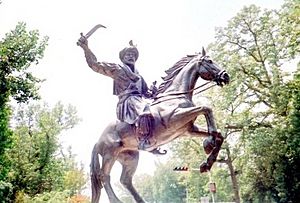Bakht Khan facts for kids
Quick facts for kids
General Bakht Khan
|
|
|---|---|

General Bakht Khan
|
|
| Born | 1797 Bijnor, Rohilkhand, Mughal empire
|
| Died | 13 May 1859 (aged 61–62) |
| Occupation | Subedar in the British East India Company, Commander-in-chief of Indian Rebels under Mughal Emperor |
| Known for | Indian Rebellion |
Bakht Khan (1797–13 May 1859) was commander-in-chief of the Indian rebel forces in the region of Delhi during the Indian Rebellion of 1857 against the East India Company.
Life story
Bakht Khan was of Rohilla heritage on his father's side while his mother was an Awadhi princess. He was born in Bijnor in Rohilkhand and later became a subedar, the chief native commanding officer, in the army of the East India Company, gaining forty years of experience in the Bengal horse artillery and seeing action in the First Anglo-Afghan War.
Before the rebellion Subedar Bakht Khan was well known to a number of British officers, including several who were to serve against him during the siege of Delhi in 1857. One colonel described him as being "a most intelligent character" who was "very fond of English society".
The revolt
Indian Rebellion of 1857 started when a group of sepoys rebelled against the introduction of rifle cartridges that were allegedly greased with pig or beef fat. This offended both Muslim soldiers, who did not eat pork and Hindu soldiers, who did not eat beef. The uprising spread rapidly in the surrounding areas of Delhi against the British.
With the outbreak of the mutiny in Bareilly, Subhedar Bahadur Khan had been acclaimed as general by the sepoys involved. When Bakht Khan heard of the rebellion in Meerut, he decided to march to Delhi to support the Mughal emperor Bahadur Shah Zafar's army. By the time Bakht Khan arrived at Delhi on 1 July 1857, with a large number of Rohilla sepoys, the city had already been taken by rebel forces and the Mughal ruler Bahadur Shah Zafar had been proclaimed Emperor of India. The Bareilly Brigade led by Bakht Khan included four regiments of Bengal Native Infantry, one of cavalry and a battery of artillery. The appearance of this substantial reinforcement, marching in good order, dismayed the British besieging Delhi and impressed Bahadur Shah Zafar. Bakht and his officers were quickly summoned to meet with the emperor.
The emperor's eldest son, Mirza Mughal, also called Mirza Zahiruddin, had been given the title of chief general, but this prince had no military experience. This was the moment when Bakht Khan along with his forces arrived in Delhi. With his arrival, the leadership position did improve. Bakht Khan's administrative abilities quickly became evident, and the emperor gave him actual authority and the title of Saheb-e-Alam Bahadur, or Lord Governor General. Khan was virtual commander of the sepoy forces, although Mirza Zahiruudin was still the commander-in-chief.
Bakht Khan faced many problems which needed his immediate attention. The first and foremost problem was financial, to solve it he obtained from the Emperor authority to collect taxes. The second problem was the logistical one of supplies, which became more and more acute with the passage of time and even more so when British forces assaulted the city in September 1857. The British had many spies and agents in the city and were constantly pressurizing Bahadur Shah to surrender. The situation around Delhi proceeded to deteriorate rapidly; Bakht Khan's leadership could not compensate for the rebels' lack of organization, supplies and military strength. Delhi was besieged on 8 June 1857. On 14 September, the British assaulted the Kashmiri Gate and Bahadur Shah fled to Humayun's Tomb before surrendering to the British against Bakht Khan's pleas, on 20 September 1857. The emperor was arrested .His sons mirza Abu baker and mirza khirz khan were shot in cold blood. Innocent civilians of Delhi were killed along with many rebel leaders some being betrayed
Bakht Khan himself left Delhi and joined rebel forces in Lucknow and Shahjahanpur. Later, Bahadur Shah Zafar was tried on the charges of treason and exiled to Rangoon, Burma where he died in 1862.
Burial
On 13 May 1859, he was mortally wounded and died. He was buried in the graveyard of Nanser, then part of Swat; now in District Buner, Khyber Pakhtunkhwa Province of Pakistan. One expert in the matters of Swat history claims that he came to Swat after the war was lost and spent the rest of his life under the protection of Akhund of Swat.

